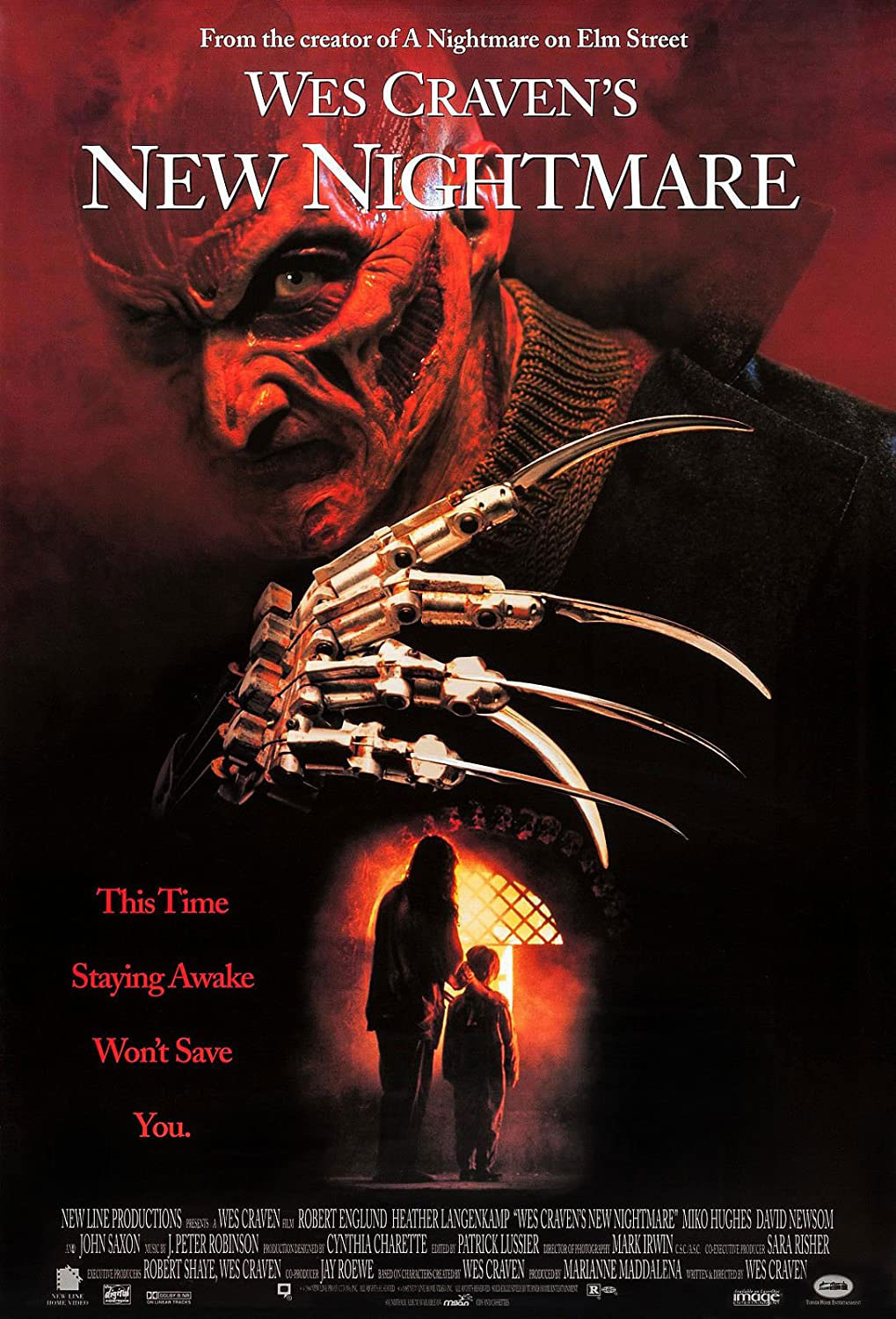Normally, I don’t like it when directors add their name to the title of a movie. John Carpenter did that all the time. Peruse this site, however, and one will find a review of John Carpenter’s Vampires listed as Vampires. The official title of the movie featured in this review is Wes Craven’s New Nightmare. That’s a different kind of conceit on the part of writer/director Wes Craven than what directors like Carpenter have done. For, that’s a literal title. In this movie, Wes Craven plays a character named Wes Craven, he is having a new nightmare, and that nightmare is causing trouble for the other characters.
Producers Robert Shaye and Sara Risher, et al, killed off their cash cow with Freddy’s Dead: The Final Nightmare, in 1991. It probably seemed like a good idea at the time, but moneymaker properties rarely stay dead for long. Just look at the superhero industry, or pro wrestling. A character like Freddy Krueger is worth real money, and it didn’t take more than a couple years for Freddy to come back from the dead.
Wes Craven came up with a pretty good idea for resurrecting Freddy. He chose to break the fourth wall. In this film, various stars and behind-the-scenes folk from the Elm Street films, along with Wes Craven, play fictionalized versions of themselves.
Heather Langenkamp, star of films 1 and 3 in the series, returns to play Heather Langenkamp, an actress married to special effects guy Chase Porter (David Newsom), and mother to young Dylan (Miko Hughes, whom viewers might remember as Gage Creed in the first Pet Sematary film).
Heather and Chase have a real good life, it seems, but Heather has been having nightmares about Freddy. She tries to dismiss these bad dreams, but something similar is affecting Dylan, as well.
Throughout a long stretch of the film, her dreams, and Dylan’s problems, continue to escalate, with little explanation as to what’s occurring. Is Freddy somehow crossing over from the fictional world into reality? Or are she and Dylan manifesting the hereditary  insanity that has plagued Heather’s family? Viewers don’t know until Craven’s big exposition scene, where he summarizes exactly what is happening for us dunces out in the audience. It’s a neat premise, but Craven did little to help the viewer understand this before literally telling us what was happening.
insanity that has plagued Heather’s family? Viewers don’t know until Craven’s big exposition scene, where he summarizes exactly what is happening for us dunces out in the audience. It’s a neat premise, but Craven did little to help the viewer understand this before literally telling us what was happening.
The final act features Heather, knowledge in hand, entering the dream world to do battle with a beefed-up, leather-wearing Freddy (as always, played by Robert Englund, who also had scenes playing himself).
New Nightmare had much more invested into its production than the other sequels in the Elm Street franchise, and it shows. Film stock, lenses, lighting, cinematography, music, sets — everything — has a polish that had been missing in the series. This is no cheapie slasher flick. Wes Craven was making a film. In that, it stands out.
While the other films indulged the worst aspects of Freddy Krueger as the series went on, Craven chose to make Freddy a more menacing presence. That restraint helps to sow tension, but it’s undermined somewhat by the film’s length. A 112-minute running time isn’t much to ask of a viewer, but Craven seemed to run a little short of ideas in the middle portion of the film, and he made up for that by stringing things along. The same goes for the finale, as well, which could have benefited from some ruthless cutting. The repetition of events slows the whole thing down to the point a viewer’s mind might start wandering away from the film.
Craven also placed a heavy burden on his child actor. Langenkamp is the star of this film, but Hughes shares almost as much screen time, and it is his character’s life that is in the greatest peril. That means this is a mama bear flick as much as it is horror. Heather’s sole purpose in this film is saving her baby, resulting in her saying or shouting his name, according to the internet (so it must be true), more than 300 times. That’s tough to sit through. At least once while watching, viewers will be rooting for Freddy to get the little bugger, just to make Heather stop screaming the kid’s name.
Elm Street is a franchise that had sunk into caricature, and it only took a couple of films to do so. Therein lies the main reason for producers to take a step back. The market for Freddy’s brand of horror was shrinking rapidly, and it was only a matter of time before they took a big loss, hence the brief hiatus after Freddy’s Dead. But, Elm Street was also a franchise that had shown nimbleness early on, and this film is a full embrace of that philosophy. It’s not a great horror film, and it will try a viewer’s patience, but it is a creative and interesting entry in the series, if not a contender for the best of the bunch.
